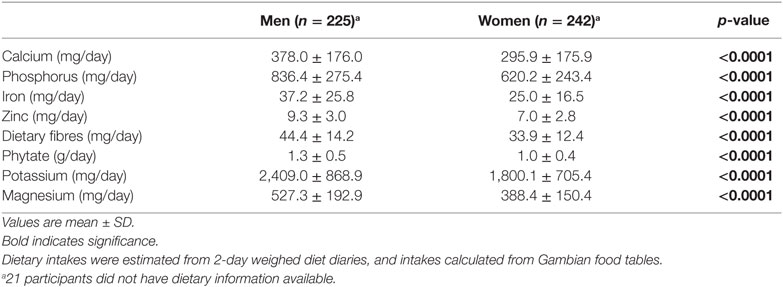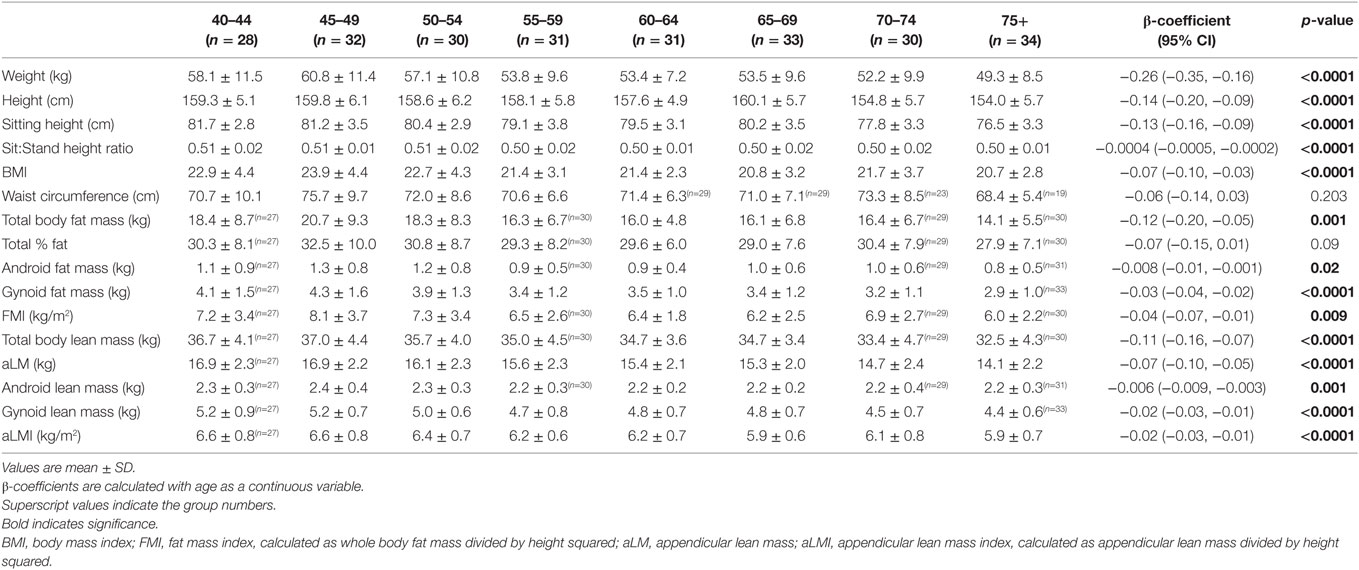The Gambian Bone and Muscle Ageing Study: Baseline Data from a Prospective Observational African Sub-Saharan Study
- 1Nutrition and Bone Health Group, MRC Elsie Widdowson Laboratory, Cambridge, United Kingdom
- 2Faculty of Medicine, Nursing and Health Sciences, Department of Medicine, School of Clinical Sciences at Monash Health, Monash University, Monash Medical Centre, Clayton, VIC, Australia
- 3International Nutritional Group, London School of Hygiene and Tropical Medicine, London, United Kingdom
- 4Calcium, Vitamin D and Bone Health Group at MRC Unit The Gambia, Banjul, Gambia
- 5Faculty of Medicine and Health Sciences, Department of Medicine, University of East Anglia, Norwich, United Kingdom
- 6MRC Lifecourse Epidemiology Unit, University of Southampton, Southampton, United Kingdom
A corrigendum on
There was a mistake in the values in Table 4 in the parameters total % fat, android fat mass, gynoid fat mass, aLM, android lean mass, and gynoid lean mass. The correct version of Table 4 appears below. The authors apologize for the mistake. This error does not change the scientific conclusions of the article.
The nutritional intake data in Table 2 was incorrectly labeled. The correct version of Table 2 appears below. We have also edited the interpretation of the data in the Results section from:
Overall, women had higher intakes of all micronutrients. Some notable sex differences include a 21% greater daily habitual calcium intake in women than in men (Table 2). The greatest sex difference was seen in daily habitual iron intake, where women had a 33% greater daily iron intake compared to men. Across the age bands, daily habitual calcium intake [mean (SD)] was 295.9 (175.9) mg/day in men and 378.0 (176.0) mg/day in women (Table 2).
To:
Overall, men had higher intakes of all micronutrients. Some notable sex differences include a 21% greater daily habitual calcium intake in men than in women (Table 2). The greatest sex difference was seen in daily habitual iron intake, where men had a 33% greater daily iron intake compared to women. Across the age bands, daily habitual calcium intake [mean (SD)] was 378.0 (176.0) mg/day in men and 295.9 (175.9) mg/day in women (Table 2).
This error does not change the scientific conclusions of the article in any way.
The original article has been updated.
Conflict of Interest Statement
The authors declare that the research was conducted in the absence of any commercial or financial relationships that could be construed as a potential conflict of interest.
Keywords: bone, ageing, Africa, muscle, dual energy X-ray absorptiometry, non-communicable disease, Gambia
Citation: Zengin A, Fulford AJ, Sawo Y, Jarjou LM, Schoenmakers I, Goldberg G, Prentice A and Ward KA (2018) Corrigendum: The Gambian Bone and Muscle Ageing Study: Baseline Data From a Prospective Observational African Sub-Saharan Study. Front. Endocrinol. 9:160. doi: 10.3389/fendo.2018.00160
Received: 09 March 2018; Accepted: 26 March 2018;
Published: 16 April 2018
Edited by:
Giacomina Brunetti, Università degli studi di Bari Aldo Moro, ItalyReviewed by:
Antonia Sophocleous, University of Edinburgh, United KingdomCopyright: © 2018 Zengin, Fulford, Sawo, Jarjou, Schoenmakers, Goldberg, Prentice and Ward. This is an open-access article distributed under the terms of the Creative Commons Attribution License (CC BY). The use, distribution or reproduction in other forums is permitted, provided the original author(s) and the copyright owner are credited and that the original publication in this journal is cited, in accordance with accepted academic practice. No use, distribution or reproduction is permitted which does not comply with these terms.
*Correspondence: Kate A. Ward, a3cmI3gwMDA0MDttcmMuc290b24uYWMudWs=
†These authors have joint senior authorship.
 Ayse Zengin
Ayse Zengin Anthony J. Fulford
Anthony J. Fulford Yankuba Sawo4
Yankuba Sawo4 Ann Prentice
Ann Prentice Kate A. Ward
Kate A. Ward
